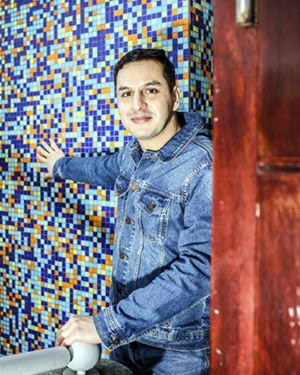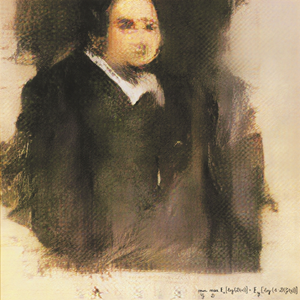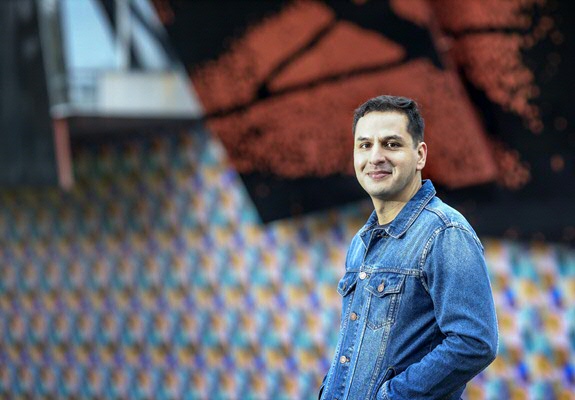What artificial art tells us about artists

Can artwork be made by subjects other than humans? And, if so, can we still call it art? According to PhD student Leonardo Arriagada, the answer is yes. A student of the Faculty of Arts, he is researching how art is made autonomously through artificial intelligence (AI). This not only provides valuable insight into how humans create art, but it can also lead to an art revolution, he says. In February this year, he won the Noorden Digitaal Talent Award for his research.
Tekst: Thomas Vos, afd. Communicatie RUG / Foto's: Henk Veenstra
Arriagada felt highly honoured to be even nominated, but could barely believe it when he actually won the Noorden Digitaal Talent Award. It was with good reason, however: both the jury and the public found his entry to be particularly inspiring because it made them think about the human relationship with art through the study of how it is made through AI: intelligence demonstrated by machines. Arriagada: ‘AI now means that art can be made fully autonomously, without human intervention. By studying that process, we can come to insights that were previously impossible.’
Invitation
Hailing from the town of Mulchén in Chile, Arriagada tells his story through Google Meet from his apartment in the centre of Groningen. Just a few days earlier, he had been introduced to Dutch culture at its finest when dozens of people went ice skating. Even though the lockdown measures in place make it hard for him to meet other people, he is excited to be in Groningen: ‘The culture is very different from what I am used to, and I am excited to start meeting people.’ The invitation to finish his PhD (which he started at the University of Chile) in Groningen at the Faculty of Arts, under the supervision of Pablo Valdivia (promotor), Florian Lippert and Alberto Godioli (daily supervisors) and Konstantin Mierau (mentor), will allow him to dive deeper into his passion.

Autonomous
But what is AI art exactly? Arriagada: ‘We have to start with a definition. Computer-generated art is art that is created by computers with a minimum of human intervention. It is a different kind of art than art that is made by humans, and does not have that spiritual or mystical connection. However, AI can simulate neural networks in our brains, so that AI-driven computers can operate autonomously, like humans. They learn by themselves and they no longer need any human intervention in that process. They are subjects with agency, just like us. Therefore, AI art is more aesthetically valuable than computer-generated art, which needed human intervention in the past.’ An example of this type of art is the painting Edmond de Belamy (2018), which is the first artwork made with AI and was auctioned for $432,500.
Creating art
As a teenager, Arriagada would watch movies like The Matrix, which sparked his interest in computer science. With the strong development of AI through the years in companies like Tesla, Arriagada’s interest only grew stronger: ‘I wanted to know more about AI and the different implications it could have for society. Tools driven by AI, such as self-driving cars, have amazing capabilities.’ As a Master’s student, he studied mathematical aspects of the human consciousness. In his PhD at the University of Chile, he decided to involve AI, strongly inspired by the rise of computer-generated artworks such as DeepDream images: ‘I am fascinated by the creation of artwork in the human brain. Now there is AI, which provides a simulation.’

Artistic brain
According to Arriagada, the advancement in AI makes it possible to understand what goes on in the brains of artists: ‘Normally, artists have an idea and they turn that into artwork. We do not know exactly what goes on in the brain between the initial idea and the finished artwork – it’s a black box. Now, however, we can look at the artificial brain that is creating art and operating autonomously, just like our brains. We have an algorithm that is making art in a way that is similar to the creation of man-made art. Therefore, by studying the process of the creation of art in the artificial brain, we can take a snapshot of what is happening, providing extremely valuable insights.’
Revolution
Moreover, Arriagada thinks that this could cause a revolution in art. He proposes a new view on artistic creativity: ‘Now, autonomous AI subjects are possible that create art but that are not organic like humans. Being a living being is therefore no longer a necessary condition to make art. We can even argue that there is a shift taking place from object to subject in technology, through AI, and from subject to object in humans. In the past, for example, humans would meet up in a coffee bar to talk. Now, they have mobile phones, which have taken over part of this human action. In the future, what was previously human action will probably be almost completely in the non-living realm. I like to call this the de-animation of the organic. Human beings are relying more and more on technology to carry out their actions.’
Future
Arriagada hopes to take this idea further: ‘I think that we are making a practical philosophy here, a practical computer science. I would love to do a postdoc to focus on this more. I want to analyse art that is created through AI while it is being made. I think Silicon Valley would be the perfect place to do this, as that’s where it is happening.’ But for now, Arriagada is happy to be in Groningen: ‘I hope to take full advantage of my chair and to strengthen my research. It would be a dream to collaborate with someone like Eric Mazur from Harvard, who is currently working with my chair at the University of Groningen. The award has definitely encouraged me to do that.’
More information
Leonardo Arriagada
More news
-
07 January 2026
How music is helping to revive the Gronings dialect
-
16 December 2025
How AI can help people with language impairments find their speech
-
18 November 2025
What about the wife beater? How language reinforces harmful ideas
